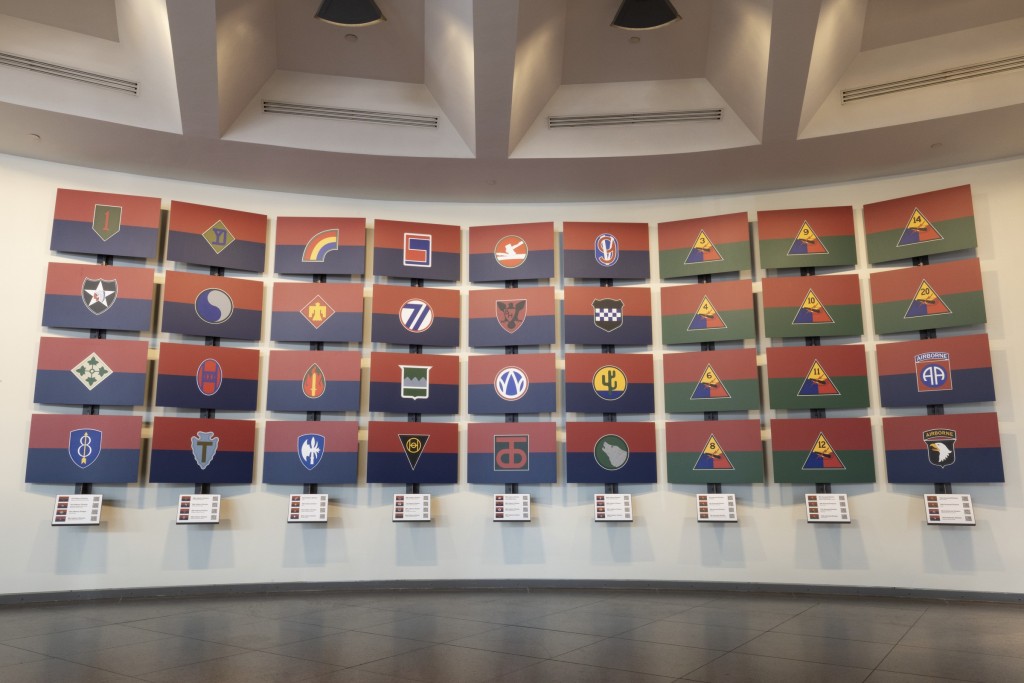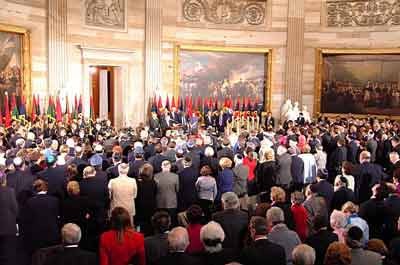
Recognition of US Liberating Army Units
The United States Holocaust Memorial Museum and the US Army's Center of Military History have worked together to define, recognize, and honor all the US Army divisions that took part in the liberation of prisoners from Nazi concentration camps and other sites of incarceration.
Key Facts
-
1
2025 marked the 80th anniversary of the liberation of concentration camps and the end of Nazi tyranny in Europe.
-
2
Liberator status is based on unit records housed at the National Archives and Records Administration. Units are recognized at the divisional level.
-
3
The honor is accorded to divisions arriving at the site within 48 hours of the initial division's encounter.
Background
In February 1985, two Holocaust survivors—Sigmund Strochlitz and Benjamin Meed—formally requested permission from the Secretary of the Army, John O. Marsh, Jr., to display in the future Museum the flags of all the US units that participated in the liberation of the Nazi camps. Strochlitz and Meed were serving then as co-chairpersons on the United States Holocaust Memorial Council's Days of Remembrance Committee. They also requested permission to present these colors at the Days of Remembrance ceremony held annually in the US Capitol Rotunda in Washington, DC. Several weeks later, the US Army agreed to cooperate with the Museum in this important joint program.
In 1985, the Museum and the Center of Military History recognized some army divisions as liberating units: the 3rd, 4th, 6th, 10th, and 11th Armored Divisions and the 42nd, 45th, 80th, 90th, and 103rd Infantry Divisions.
Guidelines
Within two years, this program generated so much interest on the part of veterans' associations that the Museum and the Center of Military History developed further guidelines and procedures for handling future requests for liberator status. It was decided to recognize units only at the divisional level; to accord the honor of liberator status on the basis of unit records housed at the National Archives and Records Administration, not oral testimony; and to accord liberator status to those divisions arriving at the site within 48 hours of the initial division's encounter.
To further facilitate this process, requests for recognition were to come through a formal petition to the Center of Military History or the Museum from the divisional association or individual members of a division. As a result of these new guidelines 10 more US Army divisions were recognized as liberating units: the 12th, 14th, and 20th Armored Divisions, and the 4th, 8th, 71st, 89th, 99th, and 104th Infantry Divisions, along with the 82nd Airborne Division.
In the years since this program was inaugurated, the Museum and the Center of Military History have recognized 36 US Army divisions for their heroism, gallantry, and help in liberating prisoners from brutal Nazi rule. Each year, the names and flags of these units are presented in a moving tribute at the US Capitol Rotunda for the Days of Remembrance ceremony.

In addition, the Museum displays 20 divisional flags at its 14th Street entrance. The flags are rotated so that all the liberating units' colors are prominently exhibited for the two million visitors who walk through our doors each year.
The United States Holocaust Memorial Museum honors the brave men and women who risked their lives to free their fellow human beings from bondage.
Liberating Units
The following US Army Divisions have been recognized as liberating units by the United States Holocaust Memorial Museum and the US Army's Center of Military History:
Infantry Divisions
1st Infantry Division
Liberated Falkenau an der Eger (Flossenbürg subcamp)
2nd Infantry Division
Liberated Leipzig-Schönefeld (Buchenwald subcamp)
Spergau (labor education camp)
4th Infantry Division
Liberated Dachau subcamp
8th Infantry Division
Liberated Wöbbelin (Neuengamme subcamp)
26th Infantry Division
Liberated Gusen (Mauthausen subcamp)
29th Infantry Division
Liberated Dinslaken (civilian labor camp)
30th Infantry Division
Liberated Weferlingen (Buchenwald subcamp)
36th Infantry Division
Liberated Kaufering camps (Dachau subcamps)
42nd Infantry Division
Liberated Dachau
45th Infantry Division
Liberated Dachau
63rd Infantry Division
Liberated Kaufering camps (Dachau subcamps)
65th Infantry Division
Liberated Flossenbürg subcamp
69th Infantry Division
Liberated Leipzig-Thekla (Buchenwald subcamp)
71st Infantry Division
Liberated Gunskirchen (Mauthausen subcamp)
80th Infantry Division
Liberated Buchenwald
Ebensee (Mauthausen subcamp)
83rd Infantry Division
Liberated Langenstein (Buchenwald subcamp)
84th Infantry Division
Liberated Ahlem (Neuengamme subcamp)
Salzwedel (Neuengamme subcamp)
86th Infantry Division
Liberated Attendorn (civilian labor camp)
89th Infantry Division
Liberated Ohrdruf (Buchenwald subcamp)
90th Infantry Division
Liberated Flossenbürg
95th Infantry Division
Liberated Werl (prison and civilian labor camp)
99th Infantry Division
Liberated Dachau subcamps
103rd Infantry Division
Kaufering subcamp
104th Infantry Division
Liberated Dora-Mittelbau
Armored Divisions
3rd Armored Division
Liberated Dora-Mittelbau
4th Armored Division
Liberated Ohrdruf (Buchenwald subcamp)
6th Armored Division
Liberated Buchenwald
8th Armored Division
Liberated Halberstadt-Zwieberge (Buchenwald subcamp)
9th Armored Division
Liberated Falkenau an der Eger (Flossenbürg subcamp)
10th Armored Division
Dachau subcamp
11th Armored Division
Liberated Gusen (Mauthausen subcamp)
Mauthausen
12th Armored Division
Liberated Dachau subcamp
14th Armored Division
Liberated Dachau subcamps
20th Armored Division
Liberated Dachau
Airborne Divisions
82nd Airborne Division
Liberated Wöbbelin (Neuengamme subcamp)
101st Airborne Division
Liberated Dachau subcamp
Critical Thinking Questions
What challenges did troops face when they encountered the camps?
Investigate liberating units from countries other than the United States.

